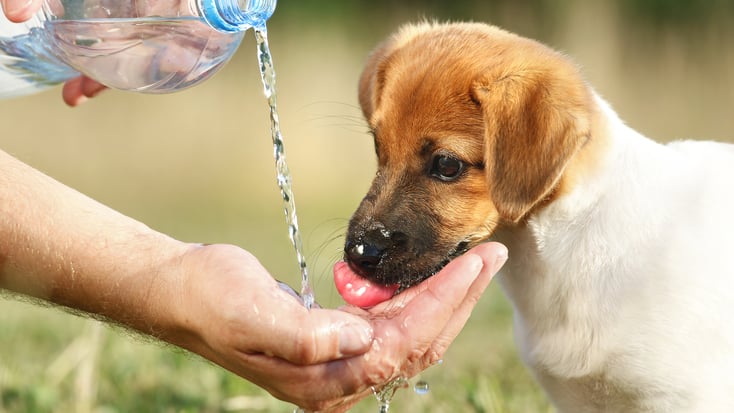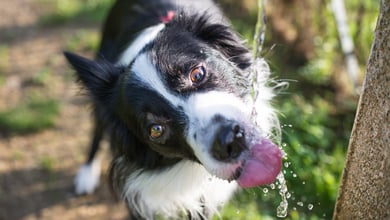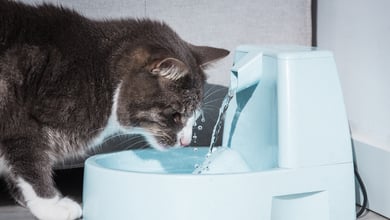How to Hydrate a Dog: 6 Vet-Approved Steps

Table of Contents
Ensuring your dog stays properly hydrated is very important for their overall well-being and functioning. Just like us, dogs rely heavily on water to support their bodily processes. And when the summer months roll in, the risk of dehydration rises, making it even more crucial to ensure they're getting enough hydration.
That's why, in this article, we aim to provide you with vet-approved steps to keep your furry companion well-hydrated and make sure they're drinking enough water.
Key Takeaways:
- Proper hydration is essential for a dog's overall well-being and bodily functions.
- Dogs need approximately one ounce of water per pound of body weight each day, but individual factors like breed and activity level may influence water requirements.
- Take immediate action if you notice signs of dehydration and consult a veterinarian if symptoms persist or worsen.
Importance of Hydration for Dogs
Proper hydration is crucial for dogs because it directly impacts their physiological functions. Water plays a vital role in a dog's body by helping regulate their body temperature, support organ function, and aid digestion.
But that's not all! Hydration also significantly promotes joint health, as it acts like a cushion and lubricant for their joints. Plus, staying well-hydrated contributes to maintaining optimal skin condition and a healthy, shiny coat.
Remember, keeping our furry friends properly hydrated is essential for their overall well-being. Let's stay attentive to their water intake and find creative ways to encourage them to drink more.
6 Vet-Approved Steps to Hydrate a Dog
Looking to keep your furry companion well-hydrated and healthy? Check out these vet-approved steps on how to effectively hydrate your dog:
1. Offer fresh, clean water at all times
Refill your dog's water bowl with fresh water throughout the day. Consider using a stainless steel or ceramic bowl, as they are easier to clean and less likely to harbor bacteria.
2. Provide access to multiple water sources
Place water bowls or fountains in various areas of your home or yard. For example, you can have a water bowl in the kitchen, one in the living room, and another in the backyard. This way, your dog can easily access water wherever they are.
3. Choose suitable water bowls or fountains
Tailor the water container to your dog's needs. If you have a large breed, opt for a bigger bowl or a self-filling water fountain. For smaller dogs, a smaller bowl or a water dispenser with a smaller opening might be preferred
4. Incorporate interactive toys and frozen treats
Get creative with hydration! Use toys that dispense water when your dog interacts with them, freeze dog-friendly broth, or offer ice chips to make hydrating treats.
5. Monitor and adjust water intake
Keep an eye on your dog's water consumption, especially during hot weather or periods of increased physical activity. If they drink excessively or show signs of dehydration, such as lethargy, dry gums, and/or sunken eyes, consult your veterinarian.
6. Water breaks during exercise
When engaging in outdoor activities or exercising with your dog, take frequent water breaks. Carry a collapsible water bowl and a bottle of water to hydrate them on the go.
How Much Water Do Dogs Need?
Curious about how much water is essential for keeping your pup properly hydrated? Determining the right amount depends on several factors, including weight, activity level, breed, and life stage.
As a general rule of thumb, it's recommended that dogs drink approximately one ounce of water per pound of body weight each day.
For instance, a 20-pound pooch would need around 20 ounces of water daily. However, it's crucial to remember that active dogs or those living in hot climates might have higher water requirements.
Additionally, certain breeds, such as larger dogs or those with thick coats, may have increased water needs to help them stay cool. Puppies, nursing or pregnant dogs, also have higher water requirements due to growth, lactation, or physiological changes.
If you want a more precise estimation of your dog's hydration needs, check out our dog hydration calculator below for a personalized recommendation.
While these guidelines can provide a helpful starting point, it's always best to observe your dog's specific needs and consult your veterinarian for personalized advice.
How Much Water Should My Dog Drink in a Day?
How Much Water Should My Dog Drink in a Day?
View Results
How Much Water Should My Dog Drink in a Day?
Based on your pet’s weight and energy level, your dog should be drinking approximately ounces of water per day
On hot days, expect your dog to need more water. Adult dogs will generally drink when thirsty, so make sure to provide lots of cool, fresh water for them. Puppies and senior dogs may need to be reminded to keep up with their water intake, so if you do not observe them drinking regularly, make sure to lead them to their water bowl and encourage them to drink.
The above calculator is meant to serve as a general guide for your pet. Every dog has their own unique needs, and therefore, we recommend that you speak to your veterinarian if you have concerns about your pet’s nutrition, including how much your dog should be drinking each day.
Share Quiz
Signs of Dehydration in Dogs
But how can you tell if your dog is becoming dehydrated? There are a few signs to watch out for.
- Dry or sticky gums: Check your dog's gums - if they appear dry or sticky instead of moist and pink, it could indicate dehydration.
- Loss of skin elasticity: Gently pinch a fold of skin on their back or neck and release it. If the skin takes longer than usual to return to its normal position, dehydration might be a concern.
- Lethargy and weakness: Pay attention to your dog's energy level. If they seem unusually tired, weak, or show a sudden lack of interest in activities, it could be a sign of dehydration.
- Excessive panting: Panting is a normal cooling mechanism for dogs, but excessive panting without a clear reason can be a sign of dehydration.
- Sunken eyes: Dehydration can cause the eyes to appear sunken or dull. Check if your dog's eyes look less full or bright than usual.
- Dry nose: A dry or sticky nose can also be an indicator of dehydration in dogs.
If you notice any of these signs in your furry friend, it's crucial to take action and provide them with water immediately. If the symptoms persist or worsen, it's advisable to schedule a visit with your veterinarian for further guidance.
Hydration Made Simple
By providing fresh, clean water at all times, ensuring multiple water sources throughout the house or yard, and using interactive toys or frozen treats to encourage water consumption, you'll be taking significant strides in keeping your furry companion hydrated and healthy.
Remember, these simple steps, along with monitoring water intake based on size, activity level, and weather conditions, can make a world of difference.
So, grab that water bowl, set up those water stations, and get creative with hydrating your pup.
Frequently Asked Questions
Can a dehydrated dog drink Pedialyte?
Giving Pedialyte to a dehydrated dog without veterinary guidance is not advisable. If your dog is dehydrated, it is recommended to seek veterinary care for appropriate treatment and rehydration methods.
Does chicken broth hydrate dogs?
Yes, chicken broth can hydrate dogs, but it should not replace their regular water intake. Use low-sodium or homemade broth without harmful ingredients like onions or garlic, which can be toxic to dogs. Consult your veterinarian for guidance if needed.
What are some foods to hydrate dogs?
Some foods that can help hydrate dogs include watermelon, cucumber, broth, as well as canned canine diets. Fruits and vegetables (and treats!) should not exceed 10% of a dog’s daily energy intake so as to avoid unbalancing the diet.
How long does it take to rehydrate a dog?
The time it takes to rehydrate a dog varies depending on the severity of dehydration and the method of rehydration (oral fluids vs subcutaneous or intravenous fluids).
Mild cases may resolve within a few hours, while more severe cases may require hospitalization for fluid administration over several hours to a day or more. Monitor your dog's hydration levels and consult a veterinarian for guidance and treatment.






